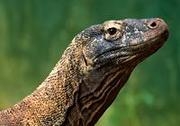Secret of dragon's bite unlocked
The Komodo dragon is deadlier than previously thought, with new research revealing the giant lizards immobilize their prey with a venomous bite before killing their victims.
The Komodo dragon is deadlier than previously thought, with new research revealing the giant lizards immobilize their prey with a venomous bite before killing their victims.

The fearsome Komodo dragon is deadlier than previously thought, with new research revealing that the giant lizards weaken and immobilize their prey with a potent venomous bite before using razor sharp teeth and powerful neck muscles to kill victims.
The carnivorous reptiles (Varanus komodoensis) are known to bite prey and release them, leaving them to bleed to death from their wounds. The victims are reported to go into shock before the dragons kill and eat them.
This overturns previous research, which shows that prey are killed by pathogenic bacteria in the dragons' mouths. The new research - published in the latest issue of Proceedings of the National Academy of Science - shows that the combination of the reptiles' teeth and venom likely accounts for their hunting prowess.
"The view that the Komodo routinely kills using dirty oral bacteria is wrong," says research co-author, Dr Stephen Wroe from the Faculty of Science at UNSW.
"The dragon is truly poisonous. It has modified salivary glands that deliver both hypertensive and anti-blood-clotting agents, which, in combination with lightweight but sophisticated cranial and dental adaptations, allows it to kill large animals through rapid blood loss," Dr Wroe says.
Read the full story on the Faculty of Science website.
Media contact: Dan Gaffney (UNSW Faculty of Science) 0411 156 015